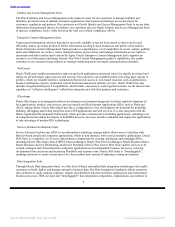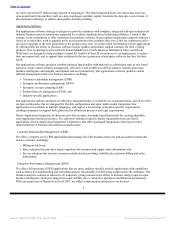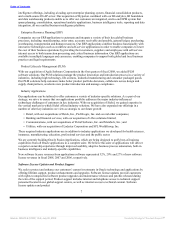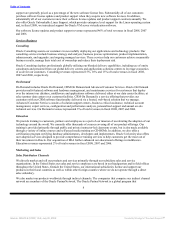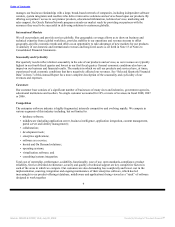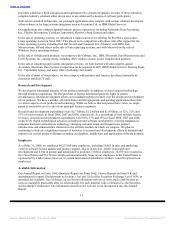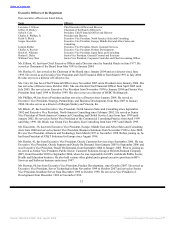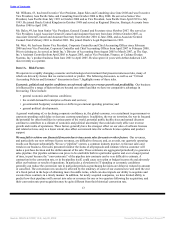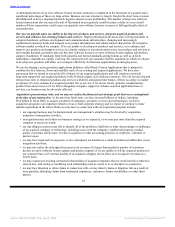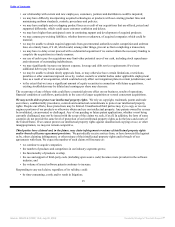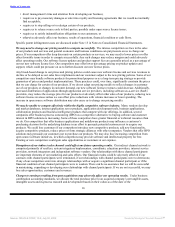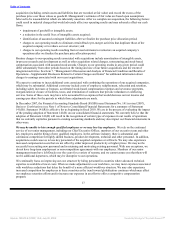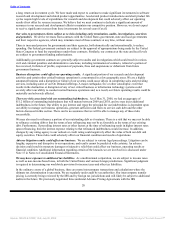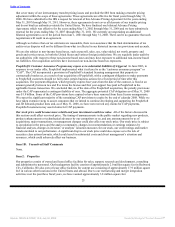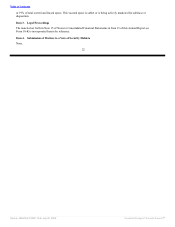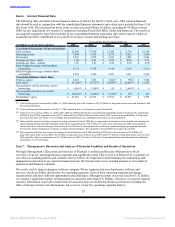Oracle 2007 Annual Report Download - page 20
Download and view the complete annual report
Please find page 20 of the 2007 Oracle annual report below. You can navigate through the pages in the report by either clicking on the pages listed below, or by using the keyword search tool below to find specific information within the annual report.
Table of Contents
• our relationship with current and new employees, customers, partners and distributors could be impaired;
• we may have difficulty incorporating acquired technologies or products with our existing product lines and
maintaining uniform standards, controls, procedures and policies;
• we may have multiple and overlapping product lines as a result of our acquisitions that are offered, priced and
supported differently, which could cause customer confusion and delays;
• we may have higher than anticipated costs in continuing support and development of acquired products;
• we may assume pre-existing liabilities, whether known or unknown, of acquired companies which could be
material;
• we may be unable to obtain required approvals from governmental authorities under competition and antitrust
laws on a timely basis, if it all, which could, among other things, prevent us from completing a transaction;
• we may have to delay or not proceed with a substantial acquisition if we cannot obtain the necessary funding to
complete the acquisition in a timely manner;
• our use of cash to pay for acquisitions may limit other potential uses of our cash, including stock repurchases
and retirement of outstanding indebtedness;
• we may significantly increase our interest expense, leverage and debt service requirements if we incur
additional debt to pay for an acquisition;
• we may be unable to obtain timely approvals from, or may otherwise have certain limitations, restrictions,
penalties or other sanctions imposed on us by, worker councils or similar bodies under applicable employment
laws as a result of an acquisition, which could adversely affect our integration plans in certain jurisdictions; and
• to the extent that we issue a significant amount of equity securities in connection with future acquisitions,
existing stockholders may be diluted and earnings per share may decrease.
The occurrence of any of these risks could have a material adverse effect on our business, results of operations,
financial condition or cash flows, particularly in the case of a larger acquisition or several concurrent acquisitions.
We may not be able to protect our intellectual property rights. We rely on copyright, trademark, patent and trade
secret laws, confidentiality procedures, controls and contractual commitments to protect our intellectual property
rights. Despite our efforts, these protections may be limited. Unauthorized third parties may try to copy or reverse
engineer portions of our products or otherwise obtain and use our intellectual property. Any patents owned by us may
be invalidated, circumvented or challenged. Any of our pending or future patent applications, whether or not being
currently challenged, may not be issued with the scope of the claims we seek, if at all. In addition, the laws of some
countries do not provide the same level of protection of our intellectual property rights as do the laws and courts of
the United States. If we cannot protect our intellectual property rights against unauthorized copying or use, or other
misappropriation, we may not remain competitive.
Third parties have claimed and, in the future, may claim infringement or misuse of intellectual property rights
and/or breach of license agreement provisions. We periodically receive notices from, or have lawsuits filed against
us by, others claiming infringement, or other misuse of their intellectual property rights and/or breach of our
agreements with them. We expect the number of such claims will increase as:
• we continue to acquire companies;
• the number of products and competitors in our industry segments grows;
• the functionality of products overlap;
• the use and support of third-party code (including open source code) becomes more prevalent in the software
industry; and
• the volume of issued software patents continues to increase.
Responding to any such claim, regardless of its validity, could:
• be time-consuming, costly and/or result in litigation;
15
Source: ORACLE CORP, 10-K, July 02, 2008 Powered by Morningstar® Document Research℠


